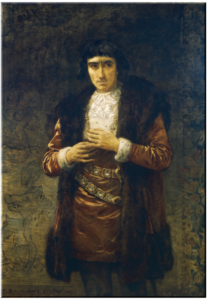Sir Henry Irving as Richard, Duke of Gloucester
Oil on canvas
Edwin Long, R.A.
English, c. 1829-d. 1891
Henry Irving, the foremost actor in England from 1866 to 1902, was the first actor to be knighted for his artistry, which helped raise the social standing of the acting profession. As the premier actor and director of the Royal Lyceum Theatre, Irving produced plays known for their lavish spectacle and melodrama. The expensive productions included the musical talents of composers Mackenzie, German, Sullivan, and Stanford and the literary contributions of Sir Arthur Conan Doyle and Alfred, Lord Tennyson.
Irving’s major achievement was in presenting a play as a unified whole rather than as an excuse to showcase one great talent. In Irving’s productions, the music, lighting, costume, sets, and interpretation of his character all supported the text and the author’s intent. This revolutionary approach to drama gave Irving a permanent place in theater history.
Irving and his leading lady Ellen Terry were especially famous for their Shakespearean roles, and this painting captures Irving in one of his most successful characters. Richard III is the story of an evil younger son who plots and murders his way to the throne of England. Here, the detailed medieval costume of dark, rich fabrics, along with Irving’s nervous gesture and shifting, sideways glance are meant to reflect the evil cunning of Richard’s character and his guilty conscience. Irving’s slight stoop reflects Richard’s physical deformity, described as a “crooked back” with “his left shoulder much higher than his right.”
Portraits of actors in costume were fairly common during the 1800s, and Irving was painted many times—most notably by Edwin Long and Sir John Everett Millais. This painting was one of three from Long commissioned by Baroness Burdett Coutts. When the portrait was exhibited at the Royal Academy of London in 1878, it was considered to be “the best portrait yet painted of the popular tragedian” and a good example of “the skill with which [Irving] made up for Richard after the best authorities for look and action.” Since Irving’s 19th-century audience knew his power as an actor and his association with this character, they would have easily understood the portrait’s significance; understanding the context increases our own appreciation today.
Published in 2013
